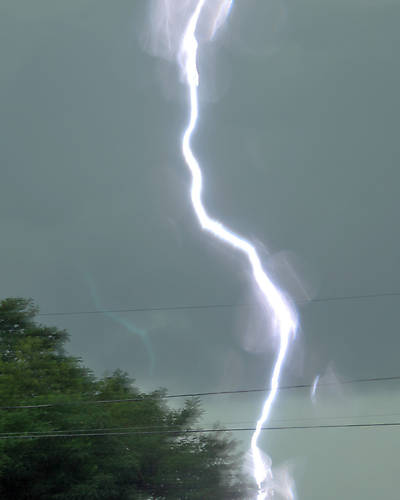Lightning Bolt near Rockville, CT 2011.
By Joe Maurath, Jr.; posted September 25, 2011
View Original: Click to zoom, then click to magnify (819 x 1024) 216KB

|
Typical lightning discharge of electrical energy connecting cloud and ground. Static build-ups within above clouds either make their connection with earth via an upwards spike or from cloud to earth. The latter is the example about 75-80% of the time. Earth to cloud discharges are less common. For example if one's hair raises during an electrical storm, then the electrical connection between earth ground (initally) is ready to complete its circuit and resultant discharge with the energized cloud above. Individual lightning disturbances typically have a duration of 3 to 7 milliseconds with their highest voltage value somewhere in between this crest. Such voltages are around 100,000 to 10 million volts at a maximum of 100,000 amperes (which is rare). Lightning arresters are designed by their engineers to handle these parameters and lengthy strokes (below). The most destructive strokes are those are those are the repeat ones, all within 1,000th of a second. Those can contain as many as 40 strokes. Most lightning discharges typically are more than one and these occur within a channel of atmosphere known as a "column" that is around a foot in diameter. Lightning strokes seem to visually last longer than the forementioned millionths of seconds because the air around their columns are so *very* superheated (hotter than the surface of the sun) that their light energy takes some visible time to dissapate. The same lengthy columnar of electrical spark as described being as so undescribably hot as it is causes ambient air molecules to thus explode and thunder results. It is known that a lot of inductive electrical energy occurs during such discharges as well as duplicate, mirrored strikes as seen background which contain far less force. Lightning-induced problems upon insulators are quite rare since they simply flashover to ground unless in the event of poor cement joints with multipart and some early suspension insulators. Otherwise the high voltage energy is bled off upon line insulators along the route. Lightning arrestors are only useful where there is generation gear, transformers or other sensitive equipment in the vicinity. Flash marks on insulators generally are the result of direct hits . Breakage only takes place when the insulator gets too hot (again, rare). Rain falling on the superheated insulator as a lightning-induced porcelain or glass unit really makes its test under these severe conditions. But again, most glass and porcelain insulators were designed to withstand such thermal shock. The lightning stroke as seen was well behind the wires in the foreground. Therefore they were not directly affected. Lightning and *all* of the other fundamentals of Electricity are still not known to this day. Electricity 303. You will be quizzed later ;-) Class dismissed! JOE ++++++++++++++ |